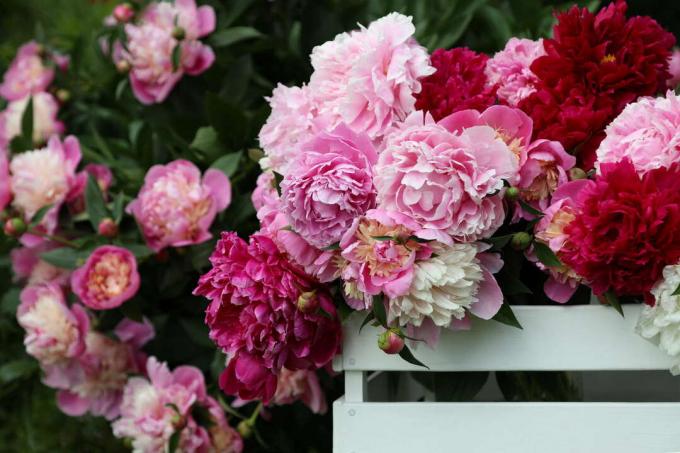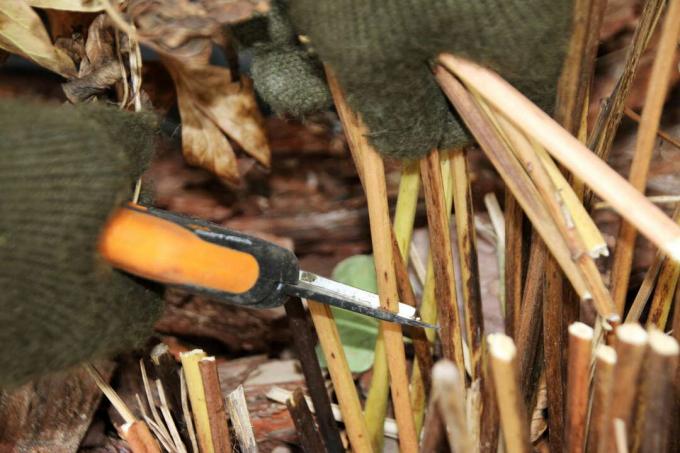Peonies - also called peonies - are among the most beautiful in the home garden. From planting the peonies to cutting them - you can find out everything here.

A peony (botanical: Paeonia) can impress the owner in many ways - be it in the garden as a beautiful perennial or as a shrub with a lush bloom, which is also able to smell excellent. The possibility of placing this plant in the vase on the living room table makes it even more attractive. If you are well informed about the many different aspects of the peony, you can help it to flower beautifully with appropriate care. This requires some dedication and patience, but the result is worth it.
contents
- Peonies: Properties, Origin & Importance
- Peony: growth forms
- Flowering time of peonies
-
Peonies: The most popular & most beautiful varieties
- Propagate peonies yourself
- plant peonies
- Planting peonies: the right location
-
Planting peonies: When is the ideal time?
- Planting peonies: the procedure
-
Peonies in the pot
- Peonies in a pot: The right substrate
-
Transplant peonies
- Peonies: why transplant?
- Peonies: how to transplant?
-
Fertilize peonies
- Fertilizing peonies: when and how often to fertilize?
- Fertilizing peonies: which fertilizer is suitable?
-
Cut peonies
- Cutting peonies: the ideal time
- Cutting peonies: procedure
- Peonies in the vase
- Peonies poisonous?
Peonies: Properties, Origin & Importance
to the plant family Paeoniaceae counts only a single genus with about 32 species, which have both different flower colors and shapes. These are divided into two separate groups: tree peonies and perennial peonies. The former come from the mountains of China, while herbaceous peonies are native to China as well as Europe, North Africa and America. Its name dates back to Greek mythology and is derived from the physician of the Olympian gods, Paion, as this plant was widely used for medicinal purposes in ancient times.
Peony: growth forms

It is important in the genus of peonies that there are two growth forms. Since both can differ in terms of growth, care and requirements, this is crucial for a satisfactory planning implementation.
- perennial peonies
These do not form lignified shoots and, like other perennials, let the above-ground parts of the plant die off in autumn. In addition, the growth height and width can differ from those of the tree peony. - tree peonies
These peonies have woody shoots and are therefore similar to the classic shrub. However, the space required by a tree peony is often much larger than that of a perennial peony. In terms of flower shapes and colors, there are no major differences, as there are a large number of different cultivated forms.
Flowering time of peonies
In Central Europe, the flowering period extends from April to June. Just before flowering, the flower buds swell to the size of golf balls, before each flower continues to delight gardeners with its blaze of color for about two weeks.

Peonies: The most popular & most beautiful varieties
There is a wide range of species and cultivars in the genus Paeonia. The varieties of the peonies listed below are first arranged according to their flower colour. For detailed descriptions of these and many other types and varieties, you can find our expert article on the best peony varieties here. This contains both a detailed overview and attractive pictures of each plant.

Propagate peonies yourself
If you want to propagate peonies yourself, this can be done in two different ways: vegetatively or generatively. In vegetative propagation, the rootstocks of the mother plant are divided and replanted separately. During generative propagation, on the other hand, the mature seeds are sown and used to create new specimens. In both approaches, there are relevant differences between perennial and shrub peonies in terms of dividing and planting. The two different types of propagation also each have advantages and disadvantages. This topic, but also many other useful facts about Propagation of Peonies are explained in detail here in our special article.
plant peonies
In order for the peony to come into its own with all its advantages, a good knowledge of its preferences in terms of location is immensely important. If this deviates significantly from its natural location, the peony (regardless of the type or variety) will always struggle and never be able to develop its full potential.
Planting peonies: the right location
The location of a peony should neither be in the sun all day nor within the shade all day. A place where the plant gets half a day's sun is ideal. The soil should be light and in no way present the risk of water stagnation.

As there are other important notes, details as well as important differences between Shrub and perennial peonies we have dedicated a separate article to this topic.
Planting peonies: When is the ideal time?
A simple rule here is to give preference to autumn. The purchased plants are delivered bare-rooted and this also ensures that the correct planting depth is maintained. In addition, planting at this time does not pose as much potential for danger as in spring, when the specimen has already formed the first sensitive shoots.
Planting peonies: the procedure
Even before the spade touches the ground, it is important to give some thought to the upcoming work steps. These steps are briefly mentioned below:
- Choose the right location in terms of space, light and soil conditions
- Dig a planting hole
- Possibly. Prepare existing soil for nutrients and drainage
- Pay attention to the correct planting depth (caution: differences between shrub and perennial peonies)
More details about the individual steps at Planting the peonies can be found here in our special article.
Peonies in the pot
With this variant, it is important to remember that the peonies in the pot can only look good for a short time. After a growing season it should therefore be considered to give the plants a place in their own Garden to reserve, otherwise root growth will very quickly reach its limits due to the narrowness of the pot bumps.

Peonies in a pot: The right substrate
The plant substrate has properties similar to the natural soil in which peonies thrive. Therefore, the same applies here: Waterlogging is deadly. You should therefore ensure that the drainage inside the pot works properly. Apart from that, a peat-free organic soil like our Plantura is suitable organic potting soil excellent for the peony.
Transplant peonies
Everything that grows and thrives develops ever greater demands for light, water, nutrients and space. Changes such as competition or footpaths in the environment also have a major impact on the plants at their location. External factors can be, for example, people walking by nearby, which cause damage, which in turn can lead to infections. In this case, you should think about transplanting the plant to a new location.
Peonies: why transplant?
The need to transplant arises in most cases from the lack of space, which occurs when the peony grows significantly larger than originally planned. Other reasons could be lack of light or water, for example due to surrounding plants that have also grown very large. This can be seen if the peony loses its willingness to bloom with each passing year or if it has to be watered conspicuously often despite the damp weather.
Peonies: how to transplant?
Here is a summary of the key steps to digging up and replanting the peonies.
- Carefully dig up the peony
- Remove root areas from the soil with water
- Cut away dried root parts
- Choose the right new location
- Dig the planting hole and possibly prepare the soil
- Plant peonies in a new location

You can also find helpful tips on exactly how to carry out these steps in our article on the Transplanting peonies.
Fertilize peonies
Peonies offer such great potential to enhance your garden that it would almost be a shame not to take advantage of it. And this is not only possible for professionals, but can also be successfully managed by hobby gardeners, provided they heed a few facts about correct fertilization.
Fertilizing peonies: when and how often to fertilize?
If you want to develop the mentioned potential of the peony, this probably has its (nutrient) price. Everyone would certainly think so at first, but the plants are already satisfied with just a few doses of fertilizer. The important factor here is the right time of fertilization. This falls in spring in March and then again in August.
Fertilizing peonies: which fertilizer is suitable?
Since the peony is one of those plants that are already satisfied with fewer nutrients, it is advisable not to use a rich mineral liquid fertilizer. A primarily organic long-term fertilizer like our Plantura Organic flower fertilizer is the best option for plant and environment.
You can find out how to optimally supply your peonies with nutrients here in our expert article on Fertilizing Peonies.
Cut peonies

By cutting, it is possible to change the shape of the plant or to create new growth stimuli. There are different cutting measures. Each one has its specific purpose as well as its optimal timing.
Cutting peonies: the ideal time
The pruning season for peonies is between summer and winter. The exact time depends on the type of cut and is therefore between June and December.
Cutting peonies: procedure
The different approaches to care and pruning vary depending on whether dead plant parts are to be removed or pruning is to be carried out at ground level. Although the latter is quite rare, it can be an advantage if the peony's growth is very stunted. In addition, the cutting methods of perennial peonies differ from those of tree peonies, which must be observed in any case.

More tips for the perfect Cut your peonies you'll find here.
Peonies in the vase
Like many other plants, peonies can be used as cut flowers for decoration. With its attractive flower shapes and colors, this plant can greatly enrich life in your own four walls. The most important thing when pruning the peony is to use a sharp pruning tool because the stems in particular can be crushed very quickly with a blunt tool and the cut is messy will.

More on when to harvest the flower stalks and other hints Peonies in the vase Is there... here.
Peonies poisonous?
The use of the peony as a medicinal plant already suggests that there are substances within the peony that can have certain effects in the human body.
what it with "Paeonin" and "Peregrenin" is all about and how you can protect yourself from unpleasant consequences, you can find out here in the article created especially for this purpose.

